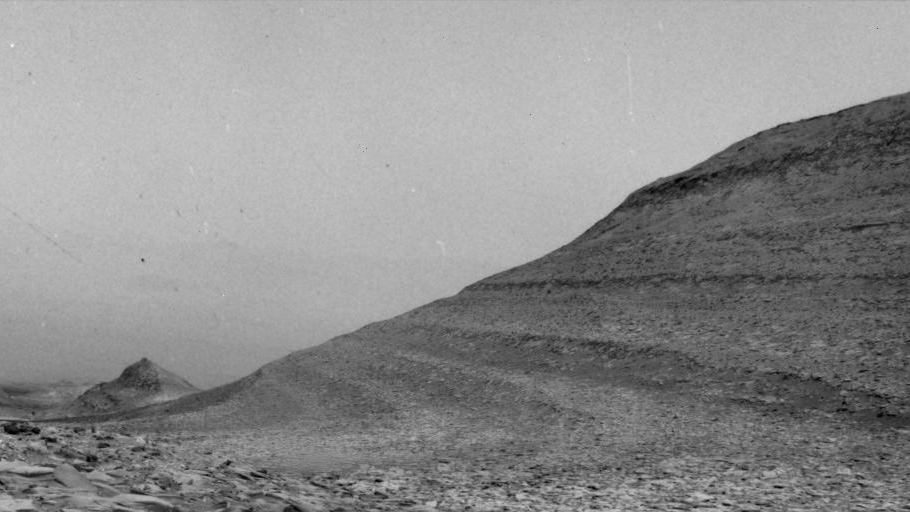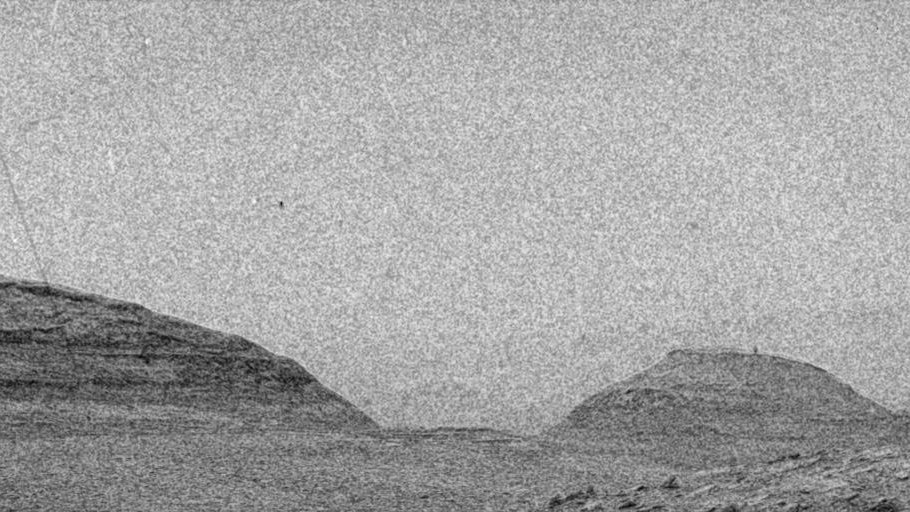Solar storm slams Mars in eerie new NASA footage
A powerful solar storm in May 2024 created auroras on Mars and provided scientists with crucial information that could aid future crewed missions to the Red Planet.

The same gigantic sunspot that was responsible for triggering a historic geomagnetic storm on Earth in mid-May whipped up a legendary one for Mars a few days later.
On May 20, data from Europe's Solar Orbiter spacecraft showed that an estimated X12 solar flare — the strongest type on the flare classification scale — erupted from the sunspot AR3664 (which was renamed AR3697 on its second trip around the sun). A powerful coronal mass ejection (CME) followed, sending a huge cloud of superhot solar plasma toward Mars at millions of miles per hour.
The impacts from this solar event provided quite an education for scientists watching everything unfold. Researchers with NASA's MAVEN orbiter, 2001 Mars Odyssey orbiter, and Curiosity Mars rover each played key roles in capturing data from the event that will help us better understand our neighboring planet and plan for future crewed visits to it.
"We really got the full range of space weather at Mars from May 11-20, from large flares, CMEs and an extreme solar energetic particle burst, and we've only begun to scratch the surface analyzing the data. The May 14th flare really did deliver as expected," Ed Thiemann, a heliophysicist at the Laboratory for Atmospheric and Space Physics (LASP) at the University of Colorado, Boulder, told Space.com in an email.
"The flare did significantly inflate and heat the Mars atmosphere as expected, and the resulting CME did indeed produce auroras," Thiemann added.
MAVEN (short for "Mars Atmosphere and Volatile Evolution") had a front-row seat for the spectacular showing of auroras over Mars. But the way that auroras are created in the Martian atmosphere is much different than what happens here on Earth.
RELATED: Earth's upper atmosphere could hold a missing piece of the universe, new study hints
Sign up for the Live Science daily newsletter now
Get the world’s most fascinating discoveries delivered straight to your inbox.
Earth has a magnetic field that protects us from charged particles. This field channels such particles toward the poles, which is why auroras are typically only visible from high latitudes. Mars, on the other hand, lost its magnetic field in ancient times and so is not shielded from these particles. So, when the particles hit Mars' atmosphere, the resulting auroras are widespread across the entire planet.
Curiosity's Radiation Assessment Detector (RAD) instrument can pick up the most energetic particles, which get all the way down to the Red Planet's surface, but it's the less energetic ones that create the stunning auroras. That's where MAVEN's Solar Energetic Particle instrument comes into play, allowing scientists to take the measure of the aurora-creating energy and recreate the event.
"This was the largest solar energetic particle event that MAVEN has ever seen," Christina Lee, MAVEN Space Weather Lead at the University of California, Berkeley's Space Sciences Laboratory, said in a recent NASA release. "There have been several solar events in past weeks, so we were seeing wave after wave of particles hitting Mars."

Curiosity's RAD instrument also played an important role, gathering information to better educate scientists on how solar storms bring impacts on the Martian surface.
For example, RAD data showed just how much radiation the particle storm generated in Curiosity's vicinity — a dose of about 8,100 micrograys. If a person had been standing next to the rover at the time, they would've soaked up the equivalent radiation of 30 chest X-rays! This was the biggest surge ever detected in Curiosity's 12-year lifespan on Mars. To give you an idea of how much solar energy was generated from this event, just look at the black-and-white camera image from a navigation camera on Curiosity (pictured above). There was so much power when the storm hit the Martian surface that white specks of "snow" were sprinkled across the picture as the charged particles smacked the camera!
Meanwhile, when Odyssey encountered the energetic particles in Mars orbit, its star camera (which is used to orient the orbiter) took a hit, getting knocked offline momentarily. Even with the brief setback, the orbiter still was able to gather details on the charged particles as well as X-rays and gamma rays with its High-Energy Neutron Detector.
And it's not just technology that can observe this phenomenon from particle blasts; humans can, too.
"The 'specks' and 'streaks' observed in the camera aboard Curiosity is not far from what astronauts see when their eyes are bombarded by radiation storm particles. In fact, astronauts aboard the ISS often describe seeing 'fireworks' when they close their eyes during radiation storms," Tamitha Skov, a retired research scientist from the Aerospace Corporation and a space weather professor at Millersville University in Pennsylvania, told Space.com in an email.
"This is because an energetic particle will deposit some energy when it passes right through the CCD sensor in a camera or the retina in the eye, and that deposited energy causes a false signal, making the camera or the eye wrongly believe it is seeing a speck or a streak of light," Skov added.
Scientists say this much radiation would not be deadly for humans, but it still serves to remind us that future visitors to the Red Planet will need to be properly shielded. The information collected provides us with a better understanding of how we can keep our Mars astronauts safe in the event of powerful solar storms, researchers say.
"Cliffsides or lava tubes would provide additional shielding for an astronaut from such an event. In Mars orbit or deep space, the dose rate would be significantly more," Don Hassler, RAD's principal investigator at the Southwest Research Institute's Solar System Science and Exploration Division in Boulder, Colorado, said in the same NASA release.
In addition to the safety of humans on the Red Planet, scientists are also worried about agricultural development there. Powerful solar storms like the one last month could make it tougher to plant and grow enough food in the planet's already challenging environment.
"Since growing plants requires sunlight, energy and lots of room, it will be difficult to grow enough food in lava tubes or caves, even if the colonists are able to supply enough artificial light to sustain their growth," Skov said. "Unlike Earth, the atmosphere on Mars is so tenuous that energetic particles can penetrate all the way to the ground. This means radiation storms, of one form or another, are a continual problem there. They are like a light drizzle ceaselessly raining down onto the surface, all the time."
With sunspot region AR3697 now making its second appearance facing Mars, researchers look forward to the opportunity to see what else they can learn from this sunspot that just doesn't want to quit.
"This same sunspot group is still active and rotated towards Mars this week, and may provide more events to aid in our understanding of the evolution and loss of the Martian atmosphere," Thiemann said.

Meredith is a regional Murrow award-winning Certified Broadcast Meteorologist and science/space correspondent. She most recently was a Freelance Meteorologist for NY 1 in New York City & the 19 First Alert Weather Team in Cleveland. A self-described "Rocket Girl," Meredith's personal and professional work has also been recognized over the last decade. This includes the inaugural Valparaiso University Alumni Association First Decade Achievement Award, two special reports in News 12's Climate Special "Saving Our Shores" that won a Regional Edward R. Murrow Award, multiple Fair Media Council Folio & Press Club of Long Island awards for meteorology & reporting, and a Long Island Business News & NYC TV Week "40 Under 40" Award. Meredith's 15 year career includes a wide variety of experience across the US stemming from her internship at WGN-TV in Chicago. Meredith worked at local television stations in New York, Ohio, South Dakota, Florida, and California and nationally with WeatherNation. Meredith is also an accomplished reporter, producing weather and science stories. This includes rocket launches at Vandenberg Space Force Base and Cape Canaveral, in depth special reports and features on NOAA's GOES-R and JPSS satellite series, and coverage on some of NASA's biggest accomplishments. She's interviewed some of the top scientists and leaders of the space & science community, being selected as the only meteorologist to travel with the GOES-West satellite from Colorado to Florida in 2017 on the C-5M Super Galaxy. Meredith frequents as a panel moderator at the Space Symposium & Satellite Conference, has been a judge for the Space Foundation's Space Technology Hall of Fame & reoccurring moderator for Foundation for the Future. Meredith spends countless hours doing school, career, & motivational talks and podcasts to help encourage women pursuing STEM careers and inspire our future generations. She moderates panels, serves as emcee for events, & conducts interviews to further storytelling on space & science topics.










